You are reading the older HTML site
Positive Feedback ISSUE
16
november/december 2004
Critical Waves:
The 2004 AES Show in
San Francisco
by
Scott Dorsey
Photographs by Dorsey; image processing and frescos by Robinson
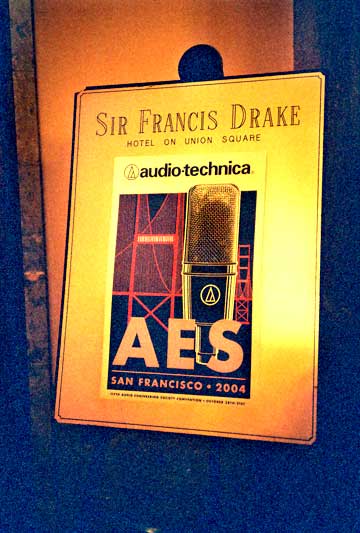
This article is a good bit shorter than most of my show reviews, but at the same time the AES show this year was considerably larger than it's been in the past few years. A huge influx of new people and products, and I have therefore tried to concentrate on what is new at the show and what might interest the high-end audio production crowd. So, I have missed a lot of the folks selling good and solid products over the years if they aren't showing anything new this time, and I must apologize for that. But this show was absolutely enormous and I felt quite overwhelmed with new items.
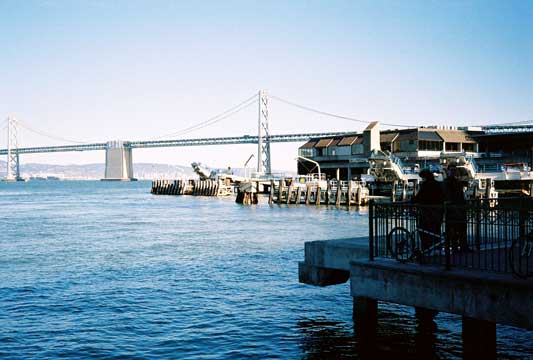
Once again, I'll say that the AES show is not only a pro audio show, it's really the only pro audio show left in the US, combined with a conference among people actually doing audio research. Most of the magazines out there totally ignore the conference itself and concentrate entirely on the vendors, but this gives short shrift to what is often the most exciting part.
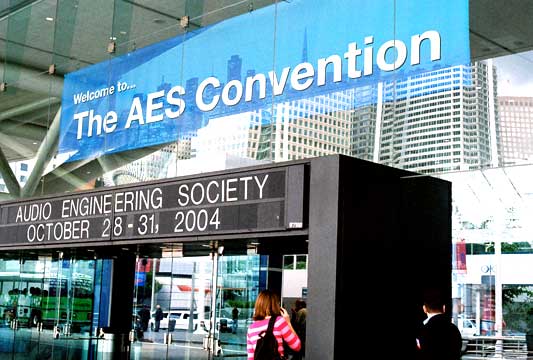
So, let me talk about the things that I found exciting this year:
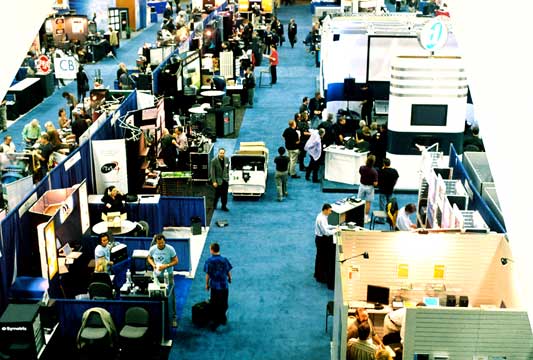
CONNECTORS
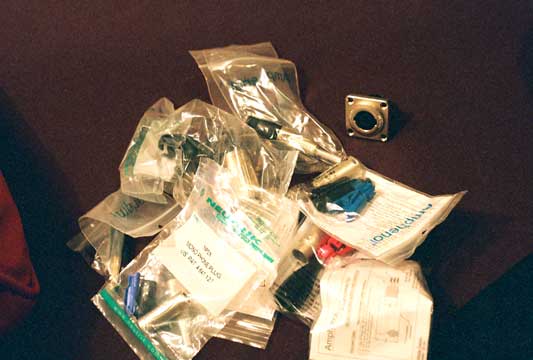
Some of Dorsey's "swag bag" of sample connectors from AES 2004 — why, a person could make a fortune at these shows!
The old Cannon connector plant in Australia was run by Alcatel for quite a while, and was a source for things like the EP-series Cannon connectors that are used for power and speaker lines on a lot of British gear, and for the older two-screw style Cannon XLR connectors. The plant is now being run by Amphenol, and while they have discontinued the old style two-screw XLRs, they are now selling a wide variety of high grade connectors. Charlie Parker of Amphenol Audio USA was mostly showing off insulation displacement XLR connectors, and the whole insulation displacement thing gives me the willies. But they were also happy to show the EP connectors, Socapex lighting connectors, and all sorts of other fine stuff. It's good to see another vendor of quality XLRs back again.
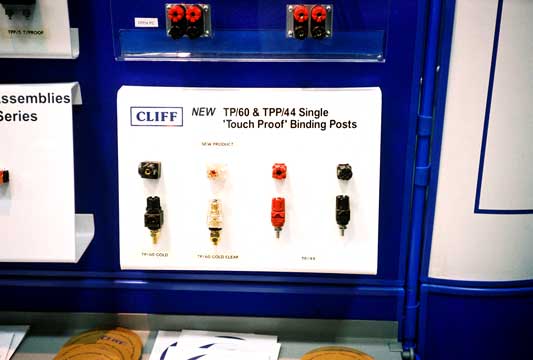
Cliff had a line of slightly cheaper connectors, all sourced in Asia, but including some reasonably solid binding post assemblies, octal sockets, and some solid pushbuttons.
No decent RCAs anywhere this year, I am sorry to say.
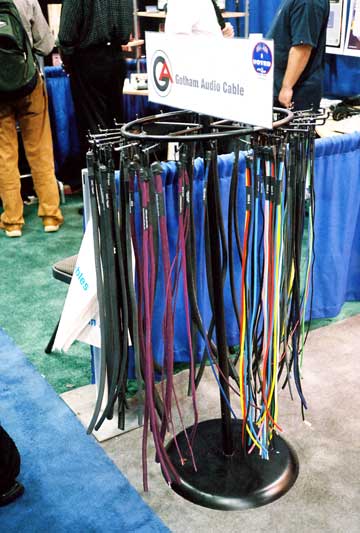
For the tręs chic fashion-conscious cable buyer, a rack of cables from Gotham Audio Cable.
CONVERTERS
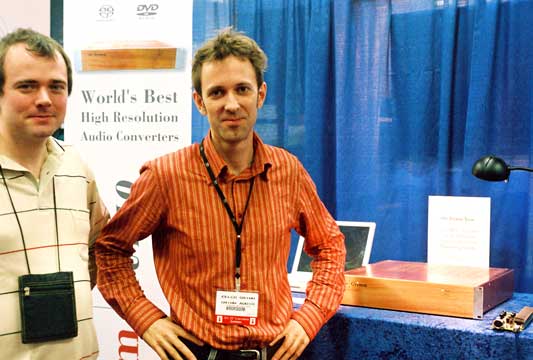
Bruno Putzeys (left) and Eelco Grimm (center) of Grimm Audio poses next to one of their DSD converters.
Eelco Grimm had a paper at the next to last AES show on design of A/D converters for DSD systems, and this year he has actually made an improved version of that design into a commercial product. The Grimm AD1 has eight channels of DSD A/D converters, implemented entirely with op-amp and comparator chips and a few discretes. The design is beautiful and the layout and construction is extremely careful. My only complaint is that the DD1 format converter box to convert to PCM output is not available yet. This box definitely is worth looking into and surely is a good step forward for the DSD crowd.
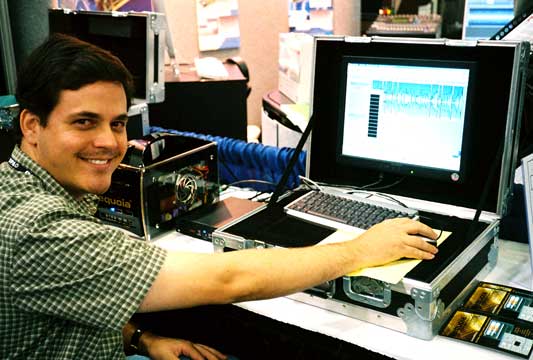
Benjamin Maas demoing the Lynx DSD-capable system.
Paul Erlandson of Lynx was also demonstrating their Aurora 8 and Aurora 16 boxes, with 8 channels of A/D and D/A conversion in one box with 192 KHz AES/EBU interfaces on back. They also had option cards for ADAT and Firewire interfaces as well. It's good to see another new entry into the high end converter market when most manufacturers are chasing after making cheaper and cheaper gear today.
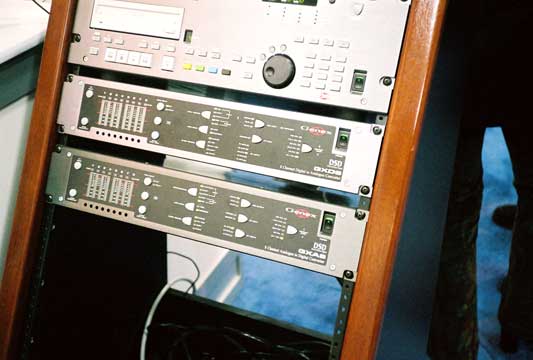
A Genex DSD converter system.
James Angus from the Acoustics Research Centre at the University of Salford has written a large number of recent papers on the design of sigma-delta modulators for converters. There's been a lot of recent discussion about look-ahead converter systems which can look forward some number of samples before deciding to output a sample, and there are several ways of doing that look-ahead. In Implementation of "Tree" and "Stack" Algorithms for Look-Ahead Sigma Delta Modulators, preprint 6281, he looks at various tradeoffs between linearity and speed of execution in these systems. This becomes only more important as we start worrying about conversion between PCM and DSD formats.
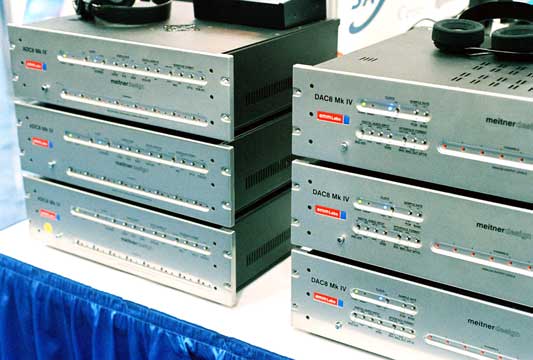
Holy DSD, Bitman! A mountain of Mighty Meitners: EMM Labs DSD converters en masse!
In Moore's Law and Digital Audio: What have we done with all the transistors?, Peter Eastty from the Sony Oxford lab gave an overview of how digital signal processing has changed since he got involved with it in 1959. The talk was a bit rambling, going through synthesis and display technologies over the years, but it made a serious point that the increase in processor performance has driven the advance in technology much less than the increase in theoretical knowledge has (although the increase in processor performance has become more necessary with each new theoretical development). He also talks a bit about a new proposed display that shows frequency information and stereo correlation on the same screen. Preprint 6278.
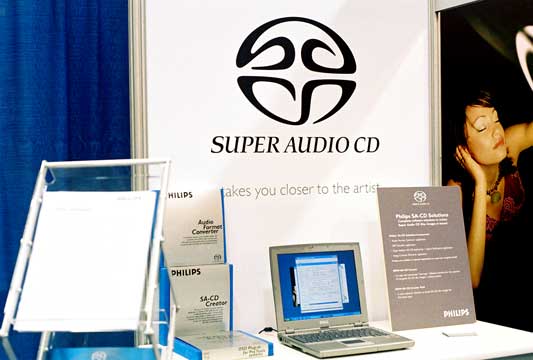
The Philips SACD display at AES 2004.
Stanley Lipshitz and John Vanderkooy from the University of Waterloo gave a talk entitled Dither Myths and Facts, which actually wasn't what it sounded like. It was a well-reasoned discussion of dither used to linearize sigma-delta converters, aimed at converter designers, and showing some of the common errors made by converter designers (and discussion of things like why attempts to tune dither levels by ear don't always work). Preprint 6279. James Angus then continued on in the same vein with A New Method of Applying High Levels of Dither to Sigma-Delta Modulators in which he continues discussing about quantizer overload problems that Lipshitz and Vanderkooy mentioned, with a very slick workaround that allows high dither levels to be applied without overload. Preprint 6296.
PARTS
The guys from Analog Devices were showing off their DSP hardware, but there was not anybody there that actually knew any of their analogue parts.
On the other hand, TI was there showing off both their DSP gear and their fine line of analogue parts from the Burr-Brown division, and they pointed me in the direction of the newer OPA 134 op-amp which looks like a good fit for audio applications where the limited stability of the OPA604 is not worth the added supply voltage range. Definitely looks like a chip to check out, and Robert Martin knew more about the audio range than pretty much any of the TI guys I'd met before.
Dale Manquen of Manco was showing Penny and Giles faders and pots, which are fabulously machined and track as well as servo-grade pots, except that they're available with useful audio tapers. The new thing they had this year was a 6-gang 10K pot with incredibly close matching, for use in 5.1 level controls. At $475 list, that's an expensive pot, but when you consider how much other electronics would be needed to replace it in order to get as good tracking, and how much sonic degradation those other electronics would produce, it seems like a good deal. This is the sort of high-end product that you won't find out about many other places.
THAT Semiconductor didn't have their long-awaited replacement for the SSM2017 mike preamp chip, but they did have something almost as interesting. Their new THAT 1200 balanced input line receiver IC is basically an electronic transformer with better noise rejection in real-world applications than most electronic input stages. They have very high common mode rejection even with a very wide range of input impedances using the InGenius circuit developed by Bill Whitlock of Jensen Transformers, and I am looking forward to trying it as a retrofit in an existing amplifier design. Incidentally, Bill Whitlock and Fred Floru gave a short talk on the design, in New Balanced Integrated Circuit Achieves Very High Dynamic Range in Real-World Systems, preprint 6261. It goes into the circuit constraints and design, although sadly not much into how the actual silicon implementation was done.
Wolfson Microelectronics was mostly demonstrating integrated circuits for low-end consumer applications like their WM8608 digital amplifier controller, which has six channels of class-D amplifier on a chip (less the output switching and filtering stages). But they also make some very interesting high grade components like their WM8798 8-channel DAC chip with both PCM and DSD inputs, and the WM8765 6-channel DAC chip. They also make s WM8765 6-channel DAC that will operate with 196 ksamp/sec sources and which has a very simple interface that might make it a good choice for a homebrew DAC project.
Power Physics had a wide array of audio amplifier modules based on class-D circuits, with phenomenal power output levels. PC boards four inches on a side with 1000 watt RMS output at reasonable distortion levels. I'm skeptical of the whole class-D thing, but I can see a lot of useful applications for these for driving very inefficient ribbon designs, for instance, or for integral subwoofers. The ability to put a huge amount of power into a load from a small box could make all kinds of currently impractical driver designs useful.
PREAMPLIFIERS
I can't really say much about preamps other than to say that everyone at the show seemed to be introducing a new preamp design.
Lavry Enginering, makers of very fine digital converters, made their first foray into a commercial preamp design. Their LavryBlue preamp is available in two or four channel configurations, with calibrated levels that can be adjusted digitally (although sadly not with a remote control). Transformerless inputs, up to 65 dB of gain in 1 dB steps with adjustable input impedance and amazingly wide bandwidth (they claim 0.1 dB down from nominal at 200 KHz).
Revolution Recording Equipment was showing their REDD47, which is a replica of a very old standard British tube design. They look to be very solidly built but I did not get any chance to listen to them.
Likewise, David Marquette of Marquette Audio Labs had their AM16, which is a replica of an old standard American transistor design of the sixties, and once again I did not get any chance to give it a real listen, but the build quality was quite fine.
Rupert Neve Designs was showing the 2022 "Portico" which is a preamplifier with a second monitoring path and headphone amplifier, more or less like what you'd find on the front end of an inline console. It's another step toward providing large-console features for people working on digital workstations today.
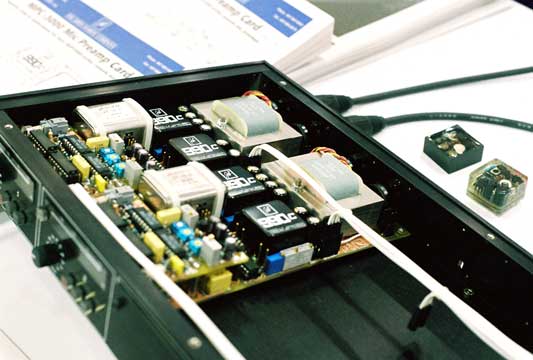
The interior of a John Hardy preamp.
And, folks like Great River, Millennia Media, and John Hardy were showing off their old standards. Good, well-built and excellent-sounding preamplifiers, all of them.
RECORDERS
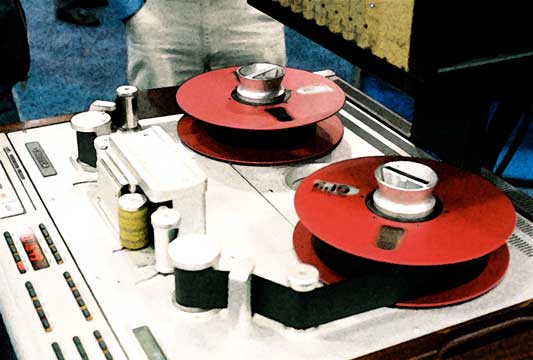
A fresco of a Studer 1" 2-track recorder at AES, warming the hearts of those who still love analog recorders.
There wasn't much on the standalone recorder front this year. JRF Magnetics was showing off a fine line of analogue tape heads and parts, and Mike Spitz from ATR Services still had his usual very fine retrofitted Ampex ATR-100 machines on display.
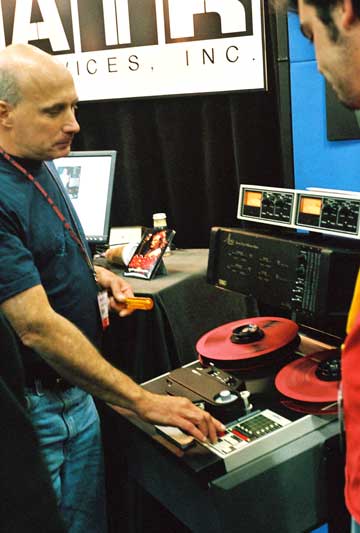
Mike Spitz of ATR Services with a 1" 2-track Ampex.
But about the only new thing that I saw that looked exciting was the Edirol R-4 portable recorder. This is a hard disk recorder that fits in one hand, recording four channels of 24 bit, 96 ksamp/sec data to an integral hard disk. And, it has a built-in editing system with a scrubbing knob that I found actually very convenient, as well as the ability to transfer files from internal disk to CompactFlash media. Designed for the film industry, I can see this being a great tool for field recordists, because it is the first small hard disk recorder I have seen that actually has usable controls rather than a clumsy menu-driven interface.
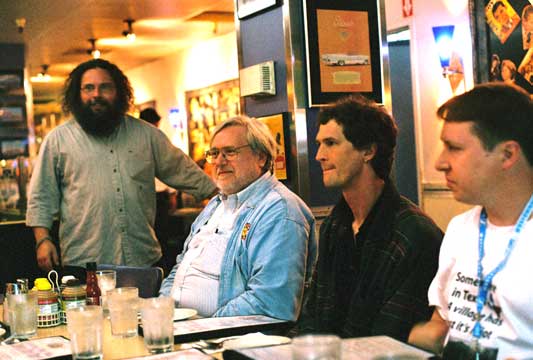
While on the subject of Ampexes, here are some members of the Ampex Users Group in attendance at AES: Bob Olsson in the blue shirt, Todd Pike in black, and David Burgess on the right with the blue name tag. The identity of the fellow on the far left is unknown.
Out in the paper sessions, things were very different with two very exciting talks on flutter removal. Jamie Howarth of Plangent Processes and Patrick Wolfe of Cambridge talked on Correction of Wow and Flutter Effects in Analog Tape Transfers. They have developed a system where the original bias signal used in recording can be recovered on playback using a special head design. Although the residual bias level is not very high, it's very narrowband which makes it easy to detect. Having this as a reference, they can detect even minute tape speed variations by demodulating variations in the recovered bias. Knowing those variations, they can undo the modulation effects with processing on playback. This results in amazingly accurate removal of even tiny amounts of scrape flutter. Since it will work on older archival recordings with no encoding needed on recording, Mr. Howarth was able to demonstrate it on a variety of old archive materials and the increase in clarity and perceived definition was just stunning. I recommend reading preprint 6213, although sadly you won't be able to hear the demo recordings that were played back during the talk, which make the point better than any paper could.
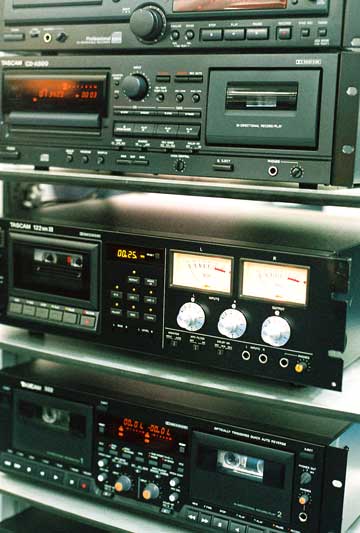
Now here's something you don't see much of, anymore: Tascam cassette recorders — and at AES, no less!
Taking a very different approach to the problem, Andrzej Czyzewski and four others from the Gdansk University of Technology had a paper on Wow detection and compensation employing spectral processing of audio. These folks used a software heuristic to estimate flutter effects on film soundtrack recordings. Clearly this is not anywhere near as accurate as the method Mr. Howarth is using, because there is no constant reference and because the original source material pitch variations need to be sorted out from pitch variations due to wow. It can handle only more severe and slow pitch effects, and that only with some human intervention. Even so, it's still a powerful and useful tool, especially for dealing with old optical soundtracks where there is no bias and no reference signal of any sort. The fact that these folks have made a heuristic pitch correction system work as well as this is a real testament to ingenuity and a real advance for archival recovery work. Preprint 6212.
Another interesting one was a paper from Hesu Huang and Chris Kyriakakis on Computationally Efficient Blind Dereverberation of Audio Signals. To remove unwanted reverberations, you need basically to know what the impulse response of the room in the original recording was, invert it, and convolve it on the data to remove that impulse response. The Constant Modulus Algorithm is one rather crude method of determining the impulse response using statistical characteristics of the signal, and these folks have found an efficient and simplified way of implementing it. Right now, dereverberation is a useful tool for teleconferencing and forensic audio, but with further advancements it might find a lot of use in higher fidelity applications. Preprint 6214.
